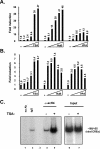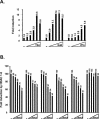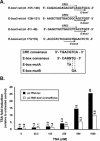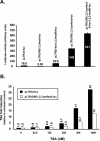Overlapping CRE and E box motifs in the enhancer sequences of the bovine leukemia virus 5' long terminal repeat are critical for basal and acetylation-dependent transcriptional activity of the viral promoter: implications for viral latency
- PMID: 15564493
- PMCID: PMC533944
- DOI: 10.1128/JVI.78.24.13848-13864.2004
Overlapping CRE and E box motifs in the enhancer sequences of the bovine leukemia virus 5' long terminal repeat are critical for basal and acetylation-dependent transcriptional activity of the viral promoter: implications for viral latency
Abstract
Bovine leukemia virus (BLV) infection is characterized by viral latency in a large proportion of cells containing an integrated provirus. In this study, we postulated that mechanisms directing the recruitment of deacetylases to the BLV 5' long terminal repeat (LTR) could explain the transcriptional repression of viral expression in vivo. Accordingly, we showed that BLV promoter activity was induced by several deacetylase inhibitors (such as trichostatin A [TSA]) in the context of episomal LTR constructs and in the context of an integrated BLV provirus. Moreover, treatment of BLV-infected cells with TSA increased H4 acetylation at the viral promoter, showing a close correlation between the level of histone acetylation and transcriptional activation of the BLV LTR. Among the known cis-regulatory DNA elements located in the 5' LTR, three E box motifs overlapping cyclic AMP responsive elements (CREs) in U3 were shown to be involved in transcriptional repression of BLV basal gene expression. Importantly, the combined mutations of these three E box motifs markedly reduced the inducibility of the BLV promoter by TSA. E boxes are susceptible to recognition by transcriptional repressors such as Max-Mad-mSin3 complexes that repress transcription by recruiting deacetylases. However, our in vitro binding studies failed to reveal the presence of Mad-Max proteins in the BLV LTR E box-specific complexes. Remarkably, TSA increased the occupancy of the CREs by CREB/ATF. Therefore, we postulated that the E box-specific complexes exerted their negative cooperative effect on BLV transcription by steric hindrance with the activators CREB/ATF and/or their transcriptional coactivators possessing acetyltransferase activities. Our results thus suggest that the overlapping CRE and E box elements in the BLV LTR were selected during evolution as a novel strategy for BLV to allow better silencing of viral transcription and to escape from the host immune response.
Figures









Similar articles
-
A complex network of transcription factors and epigenetic regulators involved in bovine leukemia virus transcriptional regulation.Retrovirology. 2023 Jun 2;20(1):11. doi: 10.1186/s12977-023-00623-w. Retrovirology. 2023. PMID: 37268923 Free PMC article. Review.
-
Suboptimal enhancer sequences are required for efficient bovine leukemia virus propagation in vivo: implications for viral latency.J Virol. 2001 Aug;75(15):6977-88. doi: 10.1128/JVI.75.15.6977-6988.2001. J Virol. 2001. PMID: 11435578 Free PMC article.
-
DNA cytosine methylation in the bovine leukemia virus promoter is associated with latency in a lymphoma-derived B-cell line: potential involvement of direct inhibition of cAMP-responsive element (CRE)-binding protein/CRE modulator/activation transcription factor binding.J Biol Chem. 2010 Jun 18;285(25):19434-49. doi: 10.1074/jbc.M110.107607. Epub 2010 Apr 22. J Biol Chem. 2010. PMID: 20413592 Free PMC article.
-
Deacetylase inhibitors and the viral transactivator TaxBLV synergistically activate bovine leukemia virus gene expression via a cAMP-responsive element- and cAMP-responsive element-binding protein-dependent mechanism.J Biol Chem. 2004 Aug 13;279(33):35025-36. doi: 10.1074/jbc.M404081200. Epub 2004 May 25. J Biol Chem. 2004. PMID: 15163662
-
Regulation of Expression and Latency in BLV and HTLV.Viruses. 2020 Sep 25;12(10):1079. doi: 10.3390/v12101079. Viruses. 2020. PMID: 32992917 Free PMC article. Review.
Cited by
-
A complex network of transcription factors and epigenetic regulators involved in bovine leukemia virus transcriptional regulation.Retrovirology. 2023 Jun 2;20(1):11. doi: 10.1186/s12977-023-00623-w. Retrovirology. 2023. PMID: 37268923 Free PMC article. Review.
-
Complete suppression of viral gene expression is associated with the onset and progression of lymphoid malignancy: observations in Bovine Leukemia Virus-infected sheep.Retrovirology. 2007 Jul 23;4:51. doi: 10.1186/1742-4690-4-51. Retrovirology. 2007. PMID: 17645797 Free PMC article.
-
E box motifs as mediators of proviral latency of human retroviruses.Retrovirology. 2009 Sep 16;6:81. doi: 10.1186/1742-4690-6-81. Retrovirology. 2009. PMID: 19758443 Free PMC article.
-
A sensitive luminescence syncytium induction assay (LuSIA) based on a reporter plasmid containing a mutation in the glucocorticoid response element in the long terminal repeat U3 region of bovine leukemia virus.Virol J. 2019 May 20;16(1):66. doi: 10.1186/s12985-019-1172-2. Virol J. 2019. PMID: 31109347 Free PMC article.
-
Cross talk between expression of the human T-cell leukemia virus type 1 Tax transactivator and the oncogenic bHLH transcription factor TAL1.J Virol. 2008 Aug;82(16):7913-22. doi: 10.1128/JVI.02414-07. Epub 2008 May 21. J Virol. 2008. PMID: 18495761 Free PMC article.
References
-
- Ahringer, J. 2000. NuRD and SIN3 histone deacetylase complexes in development. Trends Genet. 16:351-356. - PubMed
-
- Arias, J., A. S. Alberts, P. Brindle, F. X. Claret, T. Smeal, M. Karin, J. Feramisco, and M. Montminy. 1994. Activation of cAMP and mitogen responsive genes relies on a common nuclear factor. Nature 370:226-229. - PubMed
Publication types
MeSH terms
Substances
LinkOut - more resources
Full Text Sources
Research Materials

